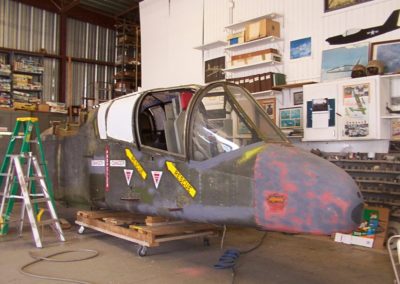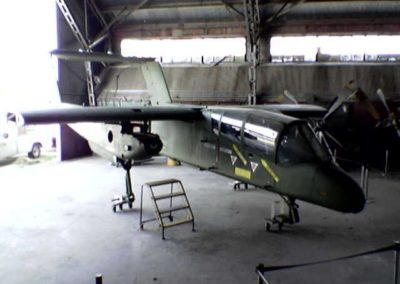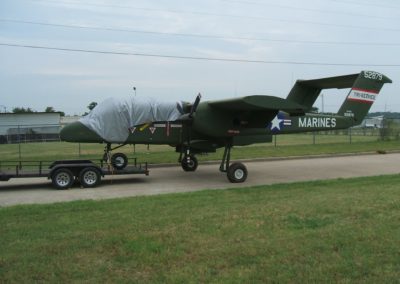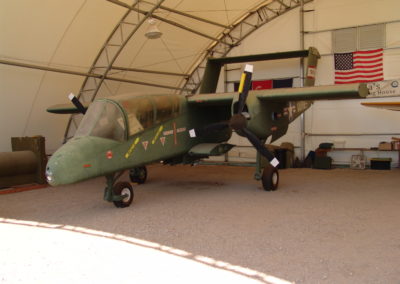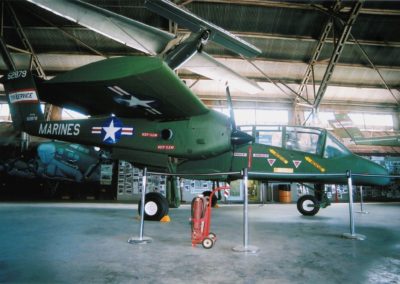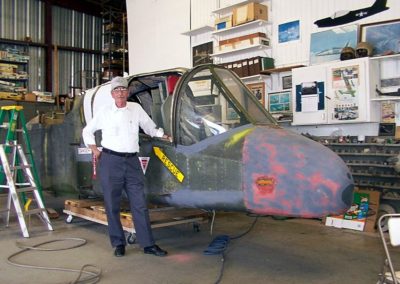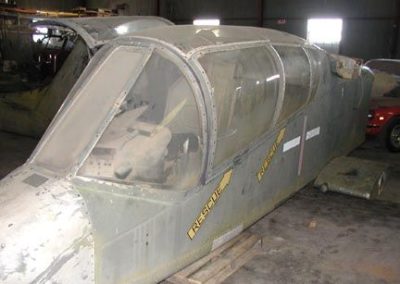OV-10 Bronco (Mockup)
This is the original factory mockup of the OV-10 Bronco and one of three OV-10s at VMAP.
Warbird Overview
This is the original factory mockup of the OV-10 Bronco and is one of three OV-10s at the Fort Worth Aviation Museum – also home to the OV-10 Bronco Association.
ABOUT THE OV-10 BRONCO (MOCKUP)
Google says mockups are “a scale or full-size model of a design or device, used for teaching, demonstration, design evaluation, promotion, and other purposes. A mockup may be a prototype if it provides at least part of the functionality of a system and enables testing of a design. Mockups are used by designers mainly to acquire feedback from users. Mock-ups address the idea captured in a popular engineering one-liner: “You can fix it now on the drafting board with an eraser or you can fix it later on the construction site with a sledgehammer”.
The OV-10A is a twin-turboprop short takeoff and landing aircraft conceived by the U.S. Marine Corps and developed under a U.S. Air Force, Navy, and Marine Corps tri-service program for a Light Armed Reconnaissance Aircraft (LARA). The North American Rockwell aircraft first flew on July 16, 1965. The first production OV-10A was ordered in 1966, and its initial flight took place in August 1967.
The Broncos US military missions included observation, forward air control, helicopter escort, armed reconnaissance, gunfire spotting, utility, and limited ground attack. The USAF acquired the Bronco primarily as a forward air control (FAC) aircraft. Adding to its versatility is a rear fuselage compartment with a capacity of 3,200 pounds of cargo or five combat-equipped troops or two litter patients and a medical attendant.
On July 6, 1968, the Marines first OV-10s arrived at Marble Mountain, Vietnam, and flew its first mission that day. The first Air Force OV-10s also arrived shortly thereafter. The nearly 300 aircraft were all produced at Air Force Plant Number 85 at Port Columbus Airport in Ohio. The last one was built in 1976.
The Air Force retired their last OV-10 in 1991, but the Marines continued to operate theirs until July 1994. Foreign governments and other US Government agencies – Bureau of Land Management, Bureau of Alcohol, Tobacco, and Firearms, and the California Department of Forestry and Fire (CDF) – continued to operate OV-10s.
Fact #1
This engineering factory mockup is the only full-sized Bronco built by North American Aviation. This mockup has many parts are carved out of wood, like the original tires.
Fact #2
The OV-10 Bronco was imagined and designed by two Marine Corps Majors over a kitchen table in the early 1960 and is still in use today.
Fact #3
This was the first mock-up aircraft acquired by the OV-10 Bronco Association, Inc., dba Fort Worth Aviation Museum.
Manufacturer: North American Aviation
Engines: Two Garrett-AiResearch T76 turboprops of 715 shaft horsepower each
Max. Speed: 281 mph
Cruising Speed: 223 mph
Range: 1,240 miles
Service Ceiling: 26,000 feet
Wingspan: 40 feet
Length: 41 feet, 7 inches
Height: 15 feet, 1 inches
Weight: 14,444 pounds maximum
Armament: Four M-60C 7.62mm machine guns in fuselage, plus 3,600 pounds of external stores. Rack mounted armament in the Vietnam War was usually seven-shot 2.75-inch rocket pods with white phosphorus marker rounds or high-explosive rockets, or 5-inch four-shot Zuni rocket pods. Bombs, air-delivered seismic sensors (ADSIDS), Mk-6 battlefield illumination flares, and other stores were carried as well.
The Fort Worth Aviation Museum has three OV-10s. This is the original, full-scale factory mockup of the OV-10A, c/n NAA-001, that was made in Columbus, Ohio. It was acquired by the museum in 2001 from a collector in California where it was found in pieces. The aircraft is made from a mix of materials. It has two sets of engine cowlings to support the Garrett and Lycoming engine types, it has a very short, 30-foot wingspan, and the sponsons are parallel to the wing.
THE original OV-10 concept full scale model. Major refresh and body repairs and is scheduled to begin sometime this summer for clean-up and painting. Funds pending.
Note: Scheduling is always a moving target depending on weather and workload. All schedules are subject to changes.
Become a Member!
FLIGHT SIMULATOR
HOURS
Saturday: 9AM-2PM
Sunday: 11AM-3PM


